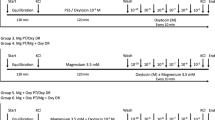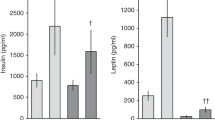Abstract
Mammary epithelial cells (MEC) are exfoliated from the epithelium into milk, influencing the number of MEC present in the udder. This process is associated with epithelium integrity. The release of oxytocin (OT) induced by milking causes myoepithelial cell contraction, which, in turn, may stimulate MEC exfoliation through mechanical forces. To investigate the role of OT in MEC exfoliation, we inhibited or induced myoepithelial cell contraction by injecting the OT receptor antagonist atosiban (Ato) or a supraphysiological dose of OT, respectively. Eight cows were assigned to 2 treatments during 2 milkings according to a crossover experimental design: Control+OT (cows were first milked to collect standard milk and then received 5 IU of OT to collect residual milk through a second milking) and Ato + OT (cows were injected with Ato (50 μg/kg of body weight) and milked to collect cisternal milk, then received 5 IU of OT to collect alveolar milk through a second milking). Milk MEC were purified to determine their concentration and number in milk. Mammary epithelium integrity was assessed by measuring the kinetics of plasma lactose concentration. Inhibiting myoepithelial cell contraction by Ato injection decreased the number of exfoliated MEC in milk. In contrast, OT injection increased the concentration of MEC in the residual milk and the number of MEC in the alveolar milk. Ato injection reduced plasma lactose concentration, whereas, in both treatments, OT injections increased it. Our results suggested that myoepithelial cell contraction caused by OT could stimulate MEC exfoliation into milk and was associated with epithelium disruption.



Similar content being viewed by others
References
Papanicolaou GN, Holmquist DG, Bader GM, Falk EA. Exfoliative cytology of the human mammary gland and its value in the diagnosis of cancer and other diseases of the breast. Cancer. 1958;11(2):377–409.
Rie EJ, Rie IP, Buehring GC. Short-term line of normal baboon mammary epithelial cells. J Natl Cancer Inst. 1976;57(3):607–11.
Kitchen BJ. Bovine mastitis: milk compositional changes and related diagnostic tests. J Dairy Res. 1981;48(01):167-88.
Boutinaud M, Jammes H. Potential uses of milk epithelial cells: a review. Reprod Nutr Dev. 2002;42(2):133–47.
Herve L, Quesnel H, Lollivier V, Boutinaud M. Regulation of cell number in the mammary gland by controlling the exfoliation process in milk in ruminants. J Dairy Sci. 2016;99(1):854–63.
Cregan MD, Fan Y, Appelbee A, Brown ML, Klopcic B, Koppen J, et al. Identification of nestin-positive putative mammary stem cells in human breastmilk. Cell Tissue Res. 2007;329(1):129–36.
Lincoln DW, Paisley AC. Neuroendocrine control of milk ejection. J Reprod Fertil. 1982;65(2):571–86.
Cross BA, Silver IA. Milk ejection and mammary engorgement. Proc R Soc Med. 1956;49(12):978-9.
Bruckmaier RM. Normal and disturbed milk ejection in dairy cows. Domest Anim Endocrinol. 2005;29(2):268–73.
Allen JC. Milk synthesis and secretion rates in cows with milk composition changed by oxytocin. J Dairy Sci. 1990;73(4):975–84.
Werner-Misof C, Pfaffl MW, Meyer HHD, Bruckmaier RM. Effect of chronic oxytocin-treatment on the bovine mammary gland immune system. Vet Med. 2007;52(11):475–86.
Wall SK, Wellnitz O, Hernández-Castellano LE, Ahmadpour A, Bruckmaier RM. Supraphysiological oxytocin increases the transfer of immunoglobulins and other blood components to milk during lipopolysaccharide- and lipoteichoic acid–induced mastitis in dairy cows. J Dairy Sci. 2016;99(11):9165–73.
Herve L, Quesnel H, Lollivier V, Portanguen J, Bruckmaier RM, Boutinaud M. Mammary epithelium disruption and mammary epithelial cell exfoliation during milking in dairy cows. J Dairy Sci. 2017;100(12):9824–34. https://doi.org/10.3168/jds.2017-13166.
Wilde CJ, Knight CH. Milk yield and mammary function in goats during and after once-daily milking. J Dairy Res. 1990;57(04):441-7.
Graf GC. Ejection of milk in relation to levels of oxytocin injected intramuscularly. J Dairy Sci. 1969;52(7):1003–7.
McAnulty PA, Burns LM. Evaluation of the maternal and neonatal effects of the oxytocin antagonist, atosiban, in a cross-fostering study in rats. Reprod Toxicol. 2004;19(1):65–70.
Bruckmaier RM, Wellnitz O, Blum JW. Inhibition of milk ejection in cows by oxytocin receptor blockade, a-adrenergic receptor stimulation and in unfamiliar surrundings. J Dairy Res. 1997;64(3):315–25.
Bruckmaier RM, Blum JW. Oxytocin release and milk removal in ruminants. J Dairy Sci. 1998;81:939–49.
Berning LM, Paape MJ, Miller RH, LeDane RA. Variation in N-Acetyl-β-D-Glucosaminidase Activity and Somatic Cell Count Among Various Milk Fractions1. J Dairy Sci. 1987;70(5):1054–60.
Sarikaya H, Schlamberger G, Meyer HHD, Bruckmaier RM. Leukocyte populations and mRNA expression of inflammatory factors in quarter milk fractions at different somatic cell score levels in dairy cows. J Dairy Sci. 2006;89(7):2479–86.
Masedunskas A, Chen Y, Stussman R, Weigert R, Mather IH. Kinetics of milk lipid droplet transport, growth, and secretion revealed by intravital imaging: lipid droplet release is intermittently stimulated by oxytocin. Mol Biol Cell. 2017;28(7):935–46.
Davis SR, Farr VC, Copeman PJA, Carruthers VR, Knight CH, Stelwagen K. Partitioning of milk accumulation between cisternal and alveolar compartments of the bovine udder: relationship to production loss during once daily milking. J Dairy Res. 1998;65(1):1–8.
Ayadi M, Caja G, Such X, Knight CH. Use of ultrasonography to estimate cistern size and milk storage at different milking intervals in the udder of dairy cows. J Dairy Res. 2003;70(1):1–7.
Wellnitz O, Bruckmaier R, Albrecht C, Blum JW. Atosiban, an oxytocin receptor blocking agent: pharmacokinetics and inhibition of milk ejection in dairy cows. J Dairy Res. 1999;66(1):1–8.
Ontsouka CE, Bruckmaier RM, Blum JW. Fractionized milk composition during removal of colostrum and mature milk. J Dairy Sci. 2003;86(6):2005–11.
Sarikaya H, Werner-Misof C, Atzkern M, Bruckmaier RM. Distribution of leucocyte populations, and milk composition, in milk fractions of healthy quarters in dairy cows. J Dairy Res. 2005;72(4):486-92.
Paape M, Mehrzad J, Zhao X, Detilleux J, Burvenich C. Defense of the bovine mammary gland by polymorphonuclear neutrophil leukocytes. J Mammary Gland Biol Neoplasia. 2002;7(2):109–21.
Olde Riekerink RGM, Barkema HW, Veenstra W, Berg FE, Stryhn H, Zadoks RN. Somatic cell count during and between milkings. J Dairy Sci. 2007;90(8):3733–41.
Nielsen NI, Larsen T, Bjerring M, Ingvartsen KL. Quarter health, milking interval, and sampling time during milking affect the concentration of milk constituents. J Dairy Sci. 2005;88(9):3186–200.
Kuhn NJ, Linzell JL. Measurement of the quantity of lactose passing into mammary venous plasma and lymph in goats and in a cow. J Dairy Res. 1970;37(2):203-8.
Sorensen A, Muir DD, Knight CH. Thrice-daily milking throughout lactation maintains epithelial integrity and thereby improves milk protein quality. J Dairy Res. 2001;68(1):15–25.
Ben Chedly H, Lacasse P, Marnet P-G, Komara M, Marion S, Boutinaud M. Use of milk epithelial cells to study regulation of cell activity and apoptosis during once-daily milking in goats. Animal. 2011;5(04):572–9.
Linzell JL, Peaker M. The effects of oxytocin and milk removal on milk secretion in the goat. J Physiol. 1971;216(3):717.
Bruckmaier RM, Schams D, Blum JW. Continuously elevated concentrations of oxytocin during milking are necessary for complete milk removal in dairy cows. J Dairy Res. 1994;61(3):323-34.
Marnet PG, Volland H, Pradelles P, Grassi J, Beaufils M. Subpicogram determination of oxytocin by an enzyme immunoassay using acetylcholinesterase as label. J Immunoass. 1994;15(1):35–53.
Acknowledgements
The authors are very grateful to Jacques Lassalas, Philippe Lamberton, Daniel Chevrel, André Cozien, Jean-Luc Harel, Pierre-Yves Pennober, Jean-Yves Thébault, and Maryvonne Texier from the Physiology team of the INRA experimental farm of Méjusseaume (UMR PEGASE, Le Rheu, France) for their helpful assistance in taking care of the cows and in sampling. The authors also thank Nicole Huchet, Morgane Kerboas, Maryline Lemarchand, Colette Mustière, Sabrina Philau, Jacques Portanguen and Sandra Wiart (INRA UMR PEGASE, St-Gilles, France) for their help in analyzing samples. Finally, the authors wish to thank Rupert Bruckmaier (Vetsuisse Faculty, Bern, Switzerland), who kindly provided atosiban, and Pierre-Guy Marnet (Agrocampus Ouest, Rennes, France) for providing the antibody and the label for OT assays. This study was conducted with the financial support of the GALA association and INRA through the RUMINFLAME project funded by GISA metaprogram 2012. Lucile Herve was supported by a PhD scholarship funded by Région Bretagne and Agrocampus-Ouest (Rennes, France).
Author information
Authors and Affiliations
Contributions
MB, VL and HQ conceived the experimental design; LH, MB and VL executed the study; LH performed the statistical analysis; LH, VL, HQ and MB contributed to interpretations; LH wrote the manuscript and MB, HQ and VL revised the manuscript. All authors read, edited and approved the manuscript.
Corresponding author
Ethics declarations
Conflict of Interest
The authors declare that they have no conflict of interest.
Rights and permissions
About this article
Cite this article
Herve, L., Lollivier, V., Quesnel, H. et al. Oxytocin Induces Mammary Epithelium Disruption and Could Stimulate Epithelial Cell Exfoliation. J Mammary Gland Biol Neoplasia 23, 139–147 (2018). https://doi.org/10.1007/s10911-018-9400-8
Received:
Accepted:
Published:
Issue Date:
DOI: https://doi.org/10.1007/s10911-018-9400-8




